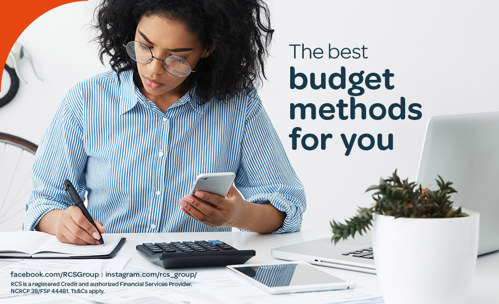The Best Budgeting Methods For You
11 AUGUST 2023
Before you start budgeting, let’s make sure you’re using the budgeting method that’s perfect for you. There are a few options available to choose from, we’ll break them down.
Choose the best budgeting system for you
Budgeting is one of the most important financial skills to have when you start to earn an income and want to start saving up. There are many ways to budget correctly according to your needs and financial goals. Finding the best method for you takes a little preparation and planning to assess your situation.
Review your finances by going over your income revenues, expenses, debts, etc. to assess why you need to budget and how you will be able to do so. A few scenarios where you could find yourself needing to the budget include; having to repay debt, learning to balance expenses, or starting to save up for a big dream. Before you decide to start budgeting, keep in mind how much maintenance and time will be needed when using a budgeting method. It becomes an added responsibility that is crucial to stick to. However, this can be more easily managed with digital budgeti10 Habits to become debt-savvyng options, in comparison to doing it manually.
Why is budgeting important? It helps you prepare and plan for those important moments in life. Budgeting helps you keep control of your spending, by forcing you to keep track of how you are spending your money on unnecessary expenses. It can also help you feel more financially stable and secure and not get overwhelmed, by keeping you out of debt and helping you stay organized. Now that you’ve assessed your situation, let’s break down the different budgeting methods and techniques.
Overview of budgeting methods:
50/20/30 Method
This method is based on dividing your after-tax income and spending 50% on needs, 30% on wants, and putting 20% toward savings.
Envelope Method
This system entails dividing up your income into each of your spending categories like bills, groceries, petrol, etc. Then you’ll decide how much you will need to spend on each category and put it in an envelope. This will keep you from overspending on what’s in the envelope.
Traditional Budgeting Method
Traditional budgeting consists of projecting your income and expenses for the next year based on a previous year’s budget.
Incremental Budgeting Method
Incremental budgeting takes into account your last year’s income and expenses and adds or subtracts a percentage to figure out your current year’s budget.
Zero-Based Budgeting Method
This bottom-up method begins with the assumption that your budgets are all zero and must be set up from scratch. This type of budgeting is tight, as everything needs to be justified.
Activity-Based Budgeting Method
This top-down method is determined by the number of inputs that are needed to reach a target.
The 50/20/30 Method
One of the simplest budgeting methods that’s simple to follow to help you reach your financial goals. 50% of your income after-tax should be spent on needs and other expenses that you cannot skip, e.g. medical aid payments, utilities, groceries. The next 50% is split between your wants (30%) like eating out, holidays, and (20%) your savings. This method is good to use if you need to manage to save for retirement or emergencies. Your wants could be optional expenses if you want to put more towards your savings. It all depends on what your goals are and how soon you need to reach them. For example, if you need to start putting together your 3 month’s worth of income towards an emergency fund, it would be worth it to flip the percentages.
The Envelope Method
By dividing your income according to each expenditure category, you’ve already planned by putting down what you can only use. This limits your overspending and helps you see where most of your money is going. If you’re not using cash, you can also use online banking/finance technology, like creating different savings accounts for each category. Money leftover in an envelope could be put towards your savings or emergency fund. Try this budget if you need to keep an eye on where you are spending your money, and how much.
The Traditional Budgeting Method
The traditional budgeting method is very commonly used in a business sense. It involves projecting your companies sales and revenue, expenses, and profits. You could also look at your previous year’s budget if you have established one already, although you will need to make adjustments according to business changes and inflation. This method is for those who own a business and need to track monthly outcomes and inputs and make changes to company spending accordingly.
The Incremental Budgeting Method
Similar to the traditional budgeting method, this method also takes the previous year’s numbers. It uses a percentage to calculate your current year's budget. It is simple enough to use if your budget doesn’t drastically change each year. It is important to remember with this method that it's possible to overcompensate for expenses and inflate your business or personal budget. Stay reasonable with your calculations to avoid this.
The Zero-Based Budgeting Method
In business, by assuming each department’s budget is zero, expenditures need to be extensively justified and approved. This keeps budgeting tight and not based on projections. This type of approach is commonly used to bring down costs and expenses or to financially restructure a company. Thus, it can be a little time-consuming as every expense needs to be addressed. Use this method if drastic change is needed in your spending habits personally, or professionally.
The Activity-Based Budgeting Method
In contrast to the above method, this is a top-down approach that works according to the amount of input/income needed to support a goal or target. If you have the goal to save a set amount of income, this means that your budget will revolve around the costs that need to be cut or taken into account to reach that amount. This is a good method to use if you have an important financial goal to reach.
Budgeting Tools & Apps
There are many budgeting tools and apps available online to help you take charge of your finances and start your budgeting process. A few of these are:
- 22seven - Free. Gives a complete overview of your finance and a personalised budget automatically.
- Moneysmart - Free. Helps you keep track of how much you spend daily.
- My Financial Life - Free. Web-based from Nedbank that helps you take control of your spending.
- MyMoney - R15 per month. Sets up an automatic feed from your bank so your income and expenditure are automatically tracked.
- Wallet - A finance tracker and budget planner on your phone.
- Mint - Web-based multi-purpose financial tool.
Search in your app store for more apps and get started today. After you’ve assessed why you need to budget, find the best method for you. Be sure to stick to your plan and if one method doesn't work out, try another from this list. Good luck with your budgeting journey!
MORE ARTICLES ABOUT
RELATED ARTICLES

Education
28 AUGUST 2025
SA Research: How Parents Impact a Child’s Financial Intelligence

Education
12 JUNE 2025
Cultivating Tomorrow's Leaders: Equipping Young South Africans for Life’s Challenges

Education
28 MARCH 2025
